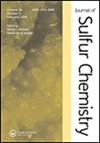Serendipitous discovery of a regioselective synthesis of novel benzoyloxy substituted phenyl/benzyl-sulfanyl/selenylbisesters, 3-benzoyloxy-3-(phenylsulfanyl)-β-lactams and their antimicrobial evaluation
IF 2.1
3区 化学
Q3 CHEMISTRY, MULTIDISCIPLINARY
引用次数: 0
Abstract
The regioselective benzoyloxylation process involves stirring a mixture of phenyl/benzyl-sulfanyl/selenylethanoate 1a-c with appropriate oxidant [benzoyl peroxide (BPO) 2a/ m-chloroperbenzoic acid (m-CPBA) 2b /bis(p-methoxybenzoyl peroxide) (BPM-BPO) 2c] under catalysis of hydrated copper acetate in toluene at 60 °C/RT. Regioselective C–H functionalization of esters 1a-c leads to benzoyloxy substituted phenyl/benzyl-sulfanyl/selenylbisesters 3a-g in good to excellent yields (80–95%). Variably substituted trans-3-phenylsulfanyl-β-lactams 4 employed for C3-H functionalization with BPO 2a generates diastereoisomeric mixture of trans- and cis-3-benzoyloxy-3-(phenylsulfanyl)-β-lactams 5 and 6 as major and minor isomers after efficient column chromatographic purification. The structural confirmation was done using IR, 1H NMR, 13C NMR, DEPT-90 NMR spectroscopic analysis and CHNS elemental analysis. In vitro antibacterial and antifungal evaluations on bisesters suggest benzylselenyl-bisester 3c as potent antimicrobial agent. Out of trans- and cis-3-benzoyloxy-β-lactams 5a and 6a, the trans isomer 5a was active against all microbial strains whereas the cis isomer 6a was completely inactive.
偶然发现的新型苯甲酰氧基取代苯基/苯基磺酰/硒基双酯,3-苯甲酰氧基-3-(苯基磺酰)-β-内酰胺的区域选择性合成及其抗菌评价
区域选择性苯甲酰氧基化过程是在水合乙酸铜的催化下,在60℃/RT下,用适当的氧化剂[过氧化苯甲酰(BPO) 2a/间氯过苯甲酸(m-CPBA) 2b /双(对甲氧基过氧化苯甲酰)(BPM-BPO) 2c]在甲苯中搅拌苯基/苄基磺酰/硒基乙醇酸1a-c的混合物。a-c酯的区域选择性C-H功能化导致苯甲酰氧基取代苯基/苄基磺酰/硒基双酯3a-g的收率很高(80-95%)。BPO 2a用于C3-H功能化的可变取代反式-3-苯基磺酰-β-内酰胺4经高效柱层析纯化后,生成反式和顺式-3-苯甲酰氧基-3-(苯基磺酰)-β-内酰胺5和6为主、次异构体的非对映异构体混合物。采用IR、1H NMR、13C NMR、DEPT-90 NMR光谱分析和CHNS元素分析对其结构进行了确证。双酯类的体外抗菌和抗真菌评价表明,苯硒基双酯3c是一种有效的抗菌药物。在反式和顺式-3-苯甲氧基-β-内酰胺5a和顺式-3-苯甲氧基-β-内酰胺6a中,反式异构体5a对所有微生物菌株都有活性,而顺式异构体6a则完全无活性。
本文章由计算机程序翻译,如有差异,请以英文原文为准。
求助全文
约1分钟内获得全文
求助全文
来源期刊

Journal of Sulfur Chemistry
CHEMISTRY, MULTIDISCIPLINARY-
CiteScore
4.10
自引率
9.10%
发文量
38
审稿时长
6-12 weeks
期刊介绍:
The Journal of Sulfur Chemistry is an international journal for the dissemination of scientific results in the rapidly expanding realm of sulfur chemistry. The journal publishes high quality reviews, full papers and communications in the following areas: organic and inorganic chemistry, industrial chemistry, materials and polymer chemistry, biological chemistry and interdisciplinary studies directly related to sulfur science.
Papers outlining theoretical, physical, mechanistic or synthetic studies pertaining to sulfur chemistry are welcome. Hence the target audience is made up of academic and industrial chemists with peripheral or focused interests in sulfur chemistry. Manuscripts that truly define the aims of the journal include, but are not limited to, those that offer: a) innovative use of sulfur reagents; b) new synthetic approaches to sulfur-containing biomolecules, materials or organic and organometallic compounds; c) theoretical and physical studies that facilitate the understanding of sulfur structure, bonding or reactivity; d) catalytic, selective, synthetically useful or noteworthy transformations of sulfur containing molecules; e) industrial applications of sulfur chemistry; f) unique sulfur atom or molecule involvement in interfacial phenomena; g) descriptions of solid phase or combinatorial methods involving sulfur containing substrates. Submissions pertaining to related atoms such as selenium and tellurium are also welcome. Articles offering routine heterocycle formation through established reactions of sulfur containing substrates are outside the scope of the journal.
 求助内容:
求助内容: 应助结果提醒方式:
应助结果提醒方式:


